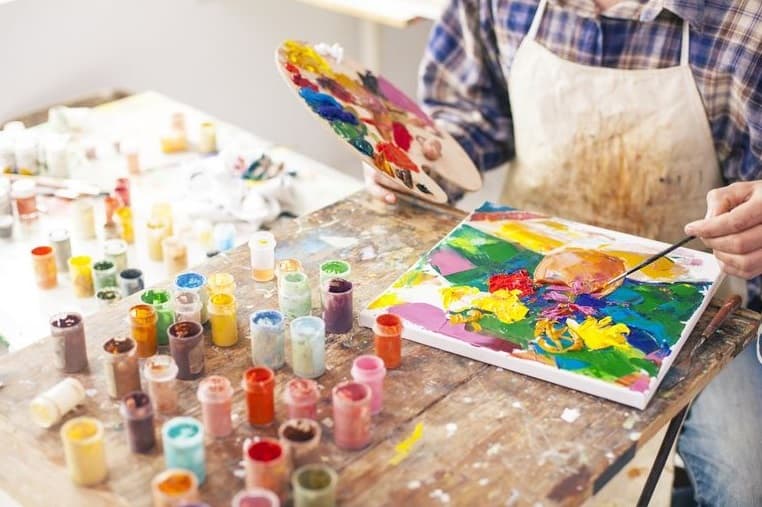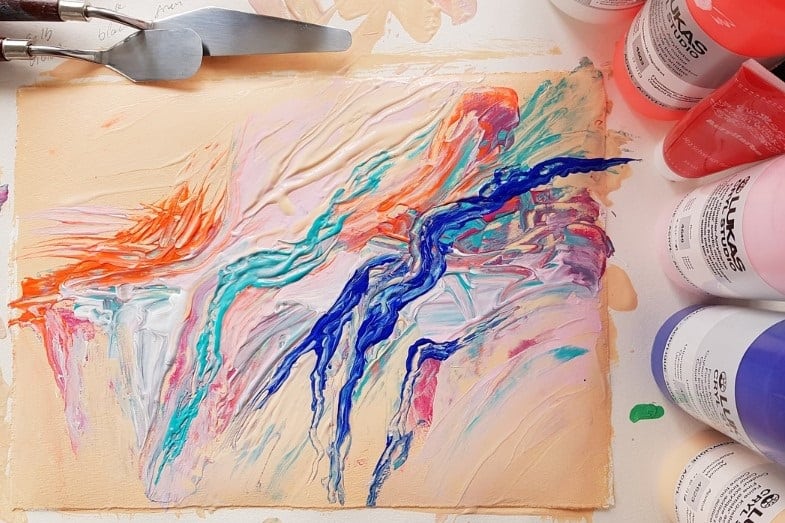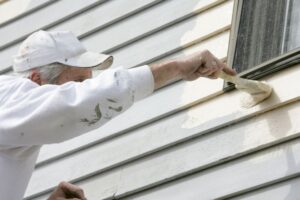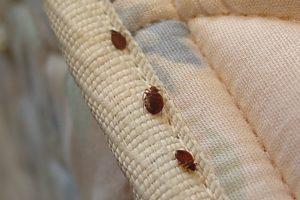Acrylic is an incredible paint medium. It dries incredibly fast and maintains its rich color throughout the drying process. In this article, I’ll describe how long it takes for acrylic paint to dry, including the factors that determine how long it takes.
How long does it take for acrylic paint to dry? The majority of acrylic paints can be ‘dry to the touch’ in just 10 to 20 minutes. A very thin layer of acrylic paint can dry in only one to two minutes. For thicker layers, the drying time could take as much as 30 minutes to about an hour.
The drying time of acrylic paint depends on the following factors:
- Quality of the Paint
- Thickness of the Paint
- Amount of Water in the Mix
- If Acrylic Gel Is Used
- Absorption Characteristics of the Canvas
- Conditions of the Painting Environment
Read on to learn more about how long it takes for acrylic paint to dry, also how to speed up the drying time.
How Long Does It Take for Acrylic Paint to Dry?
If you use a thin layer and use the right amount of water, acrylic paint will dry in just one to two minutes. However, if you are fond of layering your painting with thick paints, each acrylic paint layer can take at least 30 minutes to one hour to dry.
The actual drying time will also depend on the canvas’ porosity, the brand of the acrylic paint, and its color. But always remember that ‘dry to the touch’ does not really mean that the paint has thoroughly dried.
Generally, acrylic paints dry faster than oil paints. They also dry much faster than watercolor. Like any painting medium, acrylic paint drying time depends on many factors. While it dries faster than oil paint, many elements still affect its actual drying time.
In this regard, it is wise for you to allow your acrylic painting to dry overnight at the very least before sealing it with a varnish or any protective covering. If you don’t do this, the painting may still have some moisture, which may adversely affect the colors’ vibrancy in the future.
Before painting on your canvas, it is also recommended that you prime it with a gesso layer. This technique will prevent moisture from being absorbed by the canvas. Priming the canvas will also help quicken the drying time of acrylic paint.
Factors That Affect Acrylic Paint Drying Time
You need to understand the factors that influence the drying time of acrylic paint. The six main factors that affect how long acrylic paint takes to dry are as follows:
1. Quality of the Paint
There are expensive and cheap paints. It is common knowledge that high-quality paints have superior painting properties and optimum drying times. Cheap paints usually don’t have optimized features.
2. Thickness of the Paint
The thickness of the acrylic paint that you are applying to the canvas will also influence its drying time. A thin layer of paint only needs a shorter time to dry compared to a thicker paint layer.
Most paintings (whether oil or acrylic) are composed of multiple paint layers. As you start painting, the first layers will dry faster than the succeeding layers simply because the substrate will quickly absorb the first layer of paint.
As you proceed, you will be painting on top of previously laid paint, which in most cases, has not thoroughly dried yet. Therefore, the succeeding layers of paint will take a longer time to dry. If you want to do a quick-drying painting, limit the thickness of your paint or limit paint layering.
3. Amount of Water in the Mix
Acrylic paint with no water makes it harder to apply. Adding water to acrylic paint makes it easier to work with. Acrylic paint with a little water added to it will dry faster than other acrylic paints with more water content. More water in the paint results in a longer evaporation time. That means extra drying time for the acrylic paint.
4. If Acrylic Gel Is Used
Acrylic gels and retarders can slow down the inherent drying properties of acrylic paint. These add-ons will continue to affect the drying time of acrylic paint after the painting is finished. It is recommended that you dry the painting for at least 24 hours before doing any finishing touches.
5. Absorption Characteristics of the Canvas
If the canvas that you are painting on is very absorbent, acrylic paint will dry faster. Gesso-primed canvas is also slightly absorbent. If you are using this type of canvas, your acrylic painting will also dry faster.
The first layers of acrylic paint in a gesso-primed canvas will dry faster than the succeeding layers of paint you apply. The reason is that the second layers of paint are directly applied to the first layers of paint. If they are not fully dry, they are just the same as a canvas without gesso.

6. Conditions of the Painting Environment
The environmental conditions of where you will be painting will definitely affect your painting’s drying time. Three of the main environmental conditions that you need to be aware of are as follows:
a) Temperature
If the temperature of the place where you are painting is high, the water contained in the acrylic paint will evaporate faster. How long does it take for acrylic paint to dry in this condition?
The drying time of your painting will be faster than normal. Since acrylic paint dries faster than oil paint, you may need to use a wet palette to prevent the acrylic paint from drying out on your palette.
b) Airflow
If you are painting outdoors where airflow is steady, your acrylic painting will dry faster than usual. To prevent this, you can place your easel where there is a natural wind block. If there is none, you have to make a temporary structure that will block the airflow from going to your painting.
A wind block is necessary because it will prevent strong winds from hitting the canvas and your palette. You can also work with your back against a wall. This technique is important if you don’t want onlookers from goggling at your work.
Wind flow should not be much of a problem if you are working indoors. You can always shut the windows if the wind is blowing too hard. But don’t set your easel near the air conditioner or heater. This position will abnormally affect the drying time of your artwork.
Always remember that if you combine heat with airflow, your acrylic painting will dry even faster. If you don’t want that, avoid these conditions.
c) Humidity
Humidity is simply defined as the measurement of the amount of moisture in the air. If there is too much moisture in the air, it will take longer for your acrylic paint to dry. But if the moisture content of the air is too low, the painting will dry faster. So, you need just the right humidity, especially if you are working indoors.
A rule of thumb to follow is that increasing the humidity will slow the drying time while decreasing it will do the opposite and quicken the drying time.
So, if you are in a place where there is high humidity, your acrylic painting will dry faster. Painting with acrylic will be challenging in such areas, especially outdoors. You may need to use add-ons to your acrylic paint, like retarders and a wet palette, to prevent the acrylic paint from drying too fast.
If you work indoors, you will have more control over humidity levels. Use a heater or an air conditioner to lower levels of humidity. But don’t use a heater equipped with a humidifier. What you really need is a dehumidifier, which removes excess humidity from the air.
Different sections in your house also have varying degrees of humidity. So, you need to choose the place where humidity is the lowest. Basements usually have high humidity. If you are painting in your basement, you need to use a dehumidifier.
But if you need to paint in a room or an outdoor environment where there is very low humidity (air is too dry), you need to use a humidifier. This machine adds the right amount of humidity to the air so that you can do your work and get good results.
Estimated Drying Times for the Most Popular Acrylic Paint Colors?
To help you better choose the types and qualities of acrylic paints for your artwork, I have listed below the drying characteristics of the most popular acrylic paint colors in the market.
How long does acrylic paint take to dry? The drying time listed below is based on the information provided by their manufacturers.
| Brand of Acrylic Paint | Drying Time (Based on Company Info) |
| Tri-Art | Thin: A few minutes Thick: Several hours |
| Golden Heavy Body | Touch dry: 30 minutes Workable: 10 minutes |
| Golden Open Acrylics | Touch dry: 12 hours Workable: 1-3 hours |
| Liquitex | Thin: 10 -20 minutes Thick: One hour to several days |
| Daler-Rowney | 5-10 minutes on average |
| Winsor & Newton Professional | Thin: 20-30 minutes Thick: 1-2 hours |
| Winsor & Newton Galeria | Thin: 10-20 minutes Thick: An hour or more |
| M. Graham | An hour of working time based on temperature and humidity |
| Utrecht | Thin: 10-20 minutes Thick: 1-3 days |
Different Ways You Can Slow Down the Drying Time of Acrylic Paint
You can slow down the drying time of acrylic paint if you use the following techniques:
- Paint in a place where there is high humidity (if you are working indoors, use a humidifier to increase the humidity).
- Paint with thick layers of acrylic.
- Work in a place that has a low temperature.
- If you are working indoors, turn the air con on if it is hot.
- Add a paint retarder to the acrylic paint. You can also add acrylic gel to the paint. It will not affect the color vibrancy of the paint.
- Reduce airflow.
- If you are working outdoors, use a wind block (when working indoors, don’t work near a window).
- Paint on non-absorbent canvas and surfaces.

Different Ways to Quicken the Drying Time of Acrylic Paint
Acrylic paint dries very fast. But if you still want to make it dry faster, follow these techniques:
- Paint in thin layers.
- Work in a place where it is not too cold (if you are working indoors, increase the room’s temperature).
- Choose an area with low humidity (if you are working indoors, use a dehumidifier to decrease the room’s moisture level).
- Do not use paint retarders.
- Work in a place where there’s plenty of air (if you are painting indoors, increase the airflow in the room by opening windows or turning on an electric fan).
- Paint on canvas with an absorbent surface.
Choose Acrylic Paints That Dry Slower
If you are just starting to use acrylic paint, its quick drying time will be challenging. The colors in your palette can go dry before you can use them. An effective way of solving this problem is to choose professional acrylic paints. These types of acrylic paints are more expensive, though.
However, their drying times are much longer than ordinary acrylic paints. Although they are pricey, there will be much less paint wastage on your palette. If they don’t dry that fast, that means you can use them much longer.
The drawback is that your finished painting will also dry slower. On average, thinly applied professional acrylic paints will dry within 30 minutes. Thick layers of this type of paint take up to two hours to dry.
Conclusion – How Long Does It Take for Acrylic Paint to Dry?
So, to recap, how long does acrylic paint take to dry? Most acrylic paints can be ‘dry to the touch’ in just 10 to 20 minutes. However, if you use a thin layer of acrylic paint, it will dry in a matter of one to two minutes. Drying time for thicker layers will take as much as 30 minutes to an hour.
Its drying time also depends on other factors, such as your painting environment (i.e., temperature, humidity, and wind), the brand of your paint, the porosity of the canvas, and other related conditions.


![How Long Does DayQuil Last? [How Long It Stays in Your System] how long does dayquil last](https://howchimp.com/wp-content/uploads/2021/06/how-long-does-dayquil-last-300x200.jpg)
![How Long Does DHL Take to Deliver? [DHL Delivery Time] How Long Does DHL Take to Deliver](https://howchimp.com/wp-content/uploads/2021/05/how-long-does-DHL-take-to-deliver-300x200.jpg)
![Read more about the article Tiny Black Bugs in Bathroom [What Are They? How to Get Rid of Them?]](https://howchimp.com/wp-content/uploads/2021/05/tiny-black-bug-in-bathrooms-6-300x200.jpeg)

